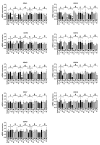Polyphenolic Compounds from Lespedeza Bicolor Root Bark Inhibit Progression of Human Prostate Cancer Cells via Induction of Apoptosis and Cell Cycle Arrest
- PMID: 32183314
- PMCID: PMC7175281
- DOI: 10.3390/biom10030451
Polyphenolic Compounds from Lespedeza Bicolor Root Bark Inhibit Progression of Human Prostate Cancer Cells via Induction of Apoptosis and Cell Cycle Arrest
Abstract
From a root bark of Lespedeza bicolor Turch we isolated two new (7 and 8) and six previously known compounds (1-6) belonging to the group of prenylated polyphenols. Their structures were elucidated using mass spectrometry, nuclear magnetic resonance and circular dichroism spectroscopy. These natural compounds selectively inhibited human drug-resistant prostate cancer in vitro. Prenylated pterocarpans 1-3 prevented the cell cycle progression of human cancer cells in S-phase. This was accompanied by a reduced expression of mRNA corresponding to several human cyclin-dependent kinases (CDKs). In contrast, compounds 4-8 induced a G1-phase cell cycle arrest without any pronounced effect on CDKs mRNA expression. Interestingly, a non-substituted hydroxy group at C-8 of ring D of the pterocarpan skeleton of compounds 1-3 seems to be important for the CDKs inhibitory activity.
Keywords: Lespedeza bicolor; Polyphenolic compounds; apoptosis; cell cycle; prostate cancer; pterocarpans.
Conflict of interest statement
The authors declare no conflict of interest.
Figures







References
-
- Sun H., Lei Y.N., Deng W., Wang H.M., Teng Y.O., Zhao H.Y., Yao Q.W., Yu P. First Total Synthesis and Cytotoxicity of Naturally Occurring Lespedezol E1. Chem. Nat. Compd. 2016;52:896–898. doi: 10.1007/s10600-016-1807-0. - DOI
-
- Glyzin V.I., Ban’kovskii A.I., Zhurba O.V., Sheichenko V.I. Flavonoids of Lespedeza bicolor. Chem. Nat. Compd. 1970;6:487–488. doi: 10.1007/BF00564266. - DOI
-
- Jae-Hak T.A.L., Jin-Woo T.A.J. Antioxidant activity of different parts of Lespedeza bicolor and isolation of antioxidant compound. Korean J. Food Sci. Technol. 2012;44:763–771.
Publication types
MeSH terms
Substances
Grants and funding
LinkOut - more resources
Full Text Sources
Medical

